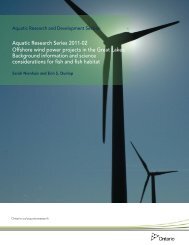Ontario's Natural Heritage Areas - Ministry of Natural Resources
Ontario's Natural Heritage Areas - Ministry of Natural Resources
Ontario's Natural Heritage Areas - Ministry of Natural Resources
Create successful ePaper yourself
Turn your PDF publications into a flip-book with our unique Google optimized e-Paper software.
4.2 Ramsar Convention Sites<br />
Introduction<br />
In 1971, at the invitation <strong>of</strong> the Government <strong>of</strong><br />
Iran, representatives from 18 countries and several<br />
international organizations met in the town <strong>of</strong> Ramsar<br />
to review global wetland issues. The delegation<br />
drafted the Convention on Wetlands <strong>of</strong> International<br />
Importance especially as Waterfowl Habitat (commonly<br />
referred to as the Ramsar Convention), which came<br />
into effect in December 1975. In January 1981 Canada<br />
became the 29th Contracting Party to the Ramsar<br />
Convention. The Ramsar Convention’s mission “is the<br />
conservation and wise use <strong>of</strong> all wetlands through<br />
local, regional and national actions and international<br />
cooperation, as a contribution towards achieving<br />
sustainable development throughout the world”<br />
(Ramsar Convention Secretariat, 1996:3).<br />
The Conference <strong>of</strong> the Contracting Parties is the<br />
Ramsar Convention’s governing body, which meets<br />
every three years to address program logistics and<br />
financing, review implementation <strong>of</strong> the convention,<br />
and set priorities. Under the Ramsar Convention,<br />
contracting parties designate sites for inclusion in the<br />
List <strong>of</strong> Wetlands <strong>of</strong> International Importance (CWS,<br />
1998; Environment Canada, 1997; Gillespie et al.,<br />
1991; Rubec and Kerr-Upal, 1996; Taylor, 2002). At<br />
present, the Ramsar Convention has 155 contracting<br />
parties with 1,674 wetland sites (totaling 150 million ha)<br />
designated for inclusion on the Ramsar List (Ramsar<br />
Convention Secretariat, 2007).<br />
The Ramsar Convention’s definition <strong>of</strong> a wetland<br />
encompasses ecosystems ranging from rivers to<br />
coastal areas, and includes coral reefs and humanmade<br />
wetlands. Wetlands can incorporate riparian and<br />
coastal zones adjacent to the wetland area, estuarine<br />
waters, and islands or bodies <strong>of</strong> marine water. Ramsar<br />
defines a wetland as any “marsh, fen, peatland or<br />
water, whether natural or artificial, permanent or<br />
temporary, with water that is static or flowing, fresh,<br />
brackish or salt, including areas <strong>of</strong> marine water<br />
the depth <strong>of</strong> which at low tide does not exceed six<br />
metres” (Ramsar Convention Secretariat, 2005). In<br />
Canada, 37 wetlands covering over 13 million ha are<br />
designated as Ramsar Convention Sites. There are<br />
eight Ramsar Convention sites in Ontario (Ramsar<br />
Convention Secretariat, 2007) (Table 4-1, Fig. 4-7).<br />
Legislation and Policy Basis<br />
The Ramsar Convention is intended to support, not<br />
override, the legislation <strong>of</strong> provincial/territorial or<br />
federal governments, and emphasizes sustainability<br />
(‘wise use’) by encouraging uses that are compatible<br />
with, and sustain, the wetland’s natural properties.<br />
For example, permitted activities should not alter or<br />
destroy the ecological character <strong>of</strong> the wetland.<br />
The Canadian Wildlife Service is responsible for the<br />
administration <strong>of</strong> Canada’s participation in the Ramsar<br />
Convention, and works cooperatively with municipal,<br />
provincial, and territorial government agencies, NGOs,<br />
as well as private landowners. In Ontario, for example,<br />
Ramsar Convention Sites are protected by federal and<br />
provincial agencies under the auspices <strong>of</strong> a number<br />
<strong>of</strong> statutes including the Canada Wildlife Act, the<br />
Migratory Birds Convention Act, and the Provincial<br />
Parks and Conservation Reserves Act. Portions <strong>of</strong> some<br />
Ramsar Convention Sites also are located on private<br />
land.<br />
Protection Goal and/or Objectives<br />
The vision for the Ramsar List is “to develop and<br />
maintain an international network <strong>of</strong> wetlands which<br />
are important for the conservation <strong>of</strong> global biological<br />
diversity and for sustaining human life through<br />
the maintenance <strong>of</strong> their ecosystem components,<br />
processes and benefits/services” (Ramsar Convention<br />
Secretariat, 2005). Four objectives are outlined by the<br />
strategic framework:<br />
• Establish national networks <strong>of</strong> Ramsar Sites in<br />
each Contracting Party which fully represent the<br />
diversity <strong>of</strong> wetlands and their key ecological and<br />
hydrological functions.<br />
• Contribute to maintaining global biological<br />
diversity through the designation and<br />
management <strong>of</strong> appropriate wetland sites.<br />
• Foster cooperation among Contracting Parties,<br />
the Convention’s international organization<br />
partners, and local stakeholders in the selection,<br />
designation, and management <strong>of</strong> Ramsar Sites.<br />
• Use the Ramsar Site network as a tool to promote<br />
national, supranational/regional, and international<br />
cooperation in relation to complementary<br />
environment treaties (Ramsar Convention<br />
Secretariat, 2005).<br />
97 Ontario’s <strong>Natural</strong> <strong>Heritage</strong> <strong>Areas</strong>

















